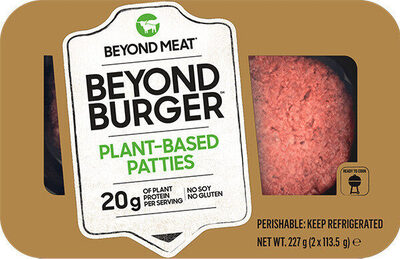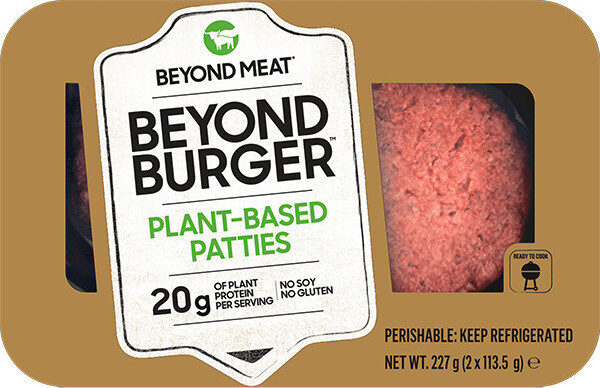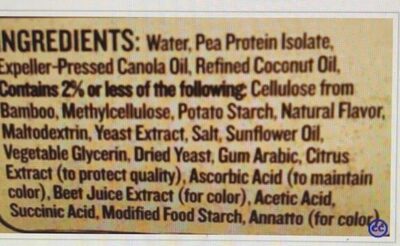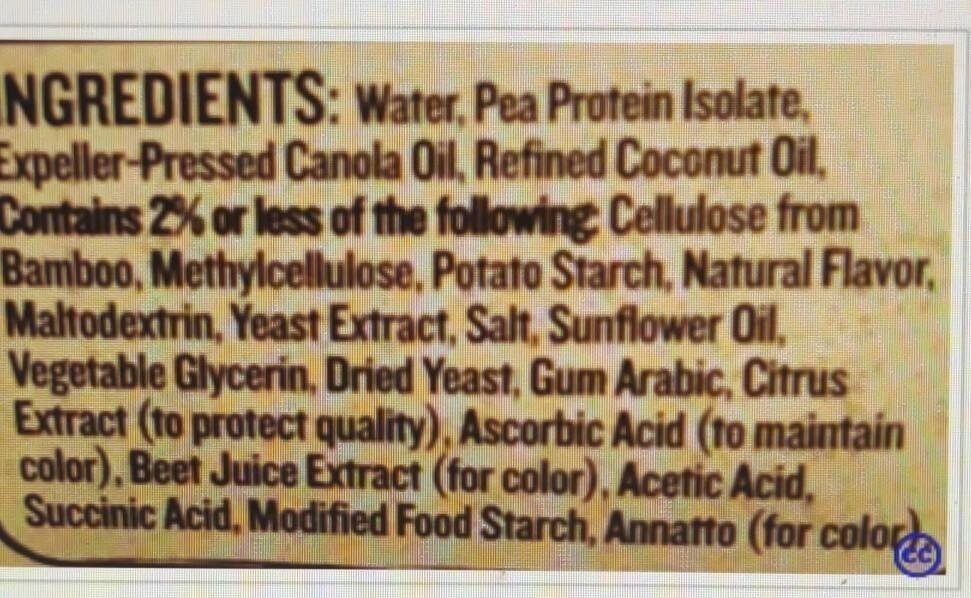Help us make food transparency the norm!
As a non-profit organization, we depend on your donations to continue informing consumers around the world about what they eat.
The food revolution starts with you!
Beyond Burger - Beyond Meat - 227 g
Beyond Burger - Beyond Meat - 227 g
This product page is not complete. You can help to complete it by editing it and adding more data from the photos we have, or by taking more photos using the app for Android or iPhone/iPad. Thank you!
×
Barcode: 0850004207024 (EAN / EAN-13) 850004207024 (UPC / UPC-A)
Common name: Plant based burger patties
Quantity: 227 g
Brands: Beyond Meat
Categories: Plant-based foods and beverages, Plant-based foods, Meat alternatives, Meat analogues, Vegetarian patties, fr:Steak vegetal
Labels, certifications, awards: Vegetarian, Vegan
Manufacturing or processing places: Columbia, Missouri, Pennsylvania, Netherlands
Countries where sold: Belgium, France, Germany, Netherlands, Spain, Switzerland
Matching with your preferences
Health
Ingredients
-
27 ingredients
Water. Pea Protein Isolate, Expeller-Pressed Canola Oil, Refined Coconut Oil, 2% or less of the following (Cellulose from Bamboo, Methylcellulose, Potato Starch, Natural Flavor, Maltodextrin, Yeast Extract, Salt, Sunflower Oil, Vegetable Glycerin, Dried Yeast, Gum Arabic, Citrus Extract (to protect quality), Ascorbic Acid (to maintain color), Beet Juice Extract (for color), Acetic Acid, Succinic Acid, Modified Food Starch, Annatto (for color))Allergens: Nuts
Food processing
-
Ultra processed foods
Elements that indicate the product is in the 4 - Ultra processed food and drink products group:
- Additive: E160b - Annatto
- Additive: E414 - Acacia gum
- Additive: E422 - Glycerol
- Additive: E461 - Methyl cellulose
- Ingredient: Colour
- Ingredient: Flavouring
- Ingredient: Maltodextrin
Food products are classified into 4 groups according to their degree of processing:
- Unprocessed or minimally processed foods
- Processed culinary ingredients
- Processed foods
- Ultra processed foods
The determination of the group is based on the category of the product and on the ingredients it contains.
Additives
-
E260 - Acetic acid
Acetic acid: Acetic acid , systematically named ethanoic acid , is a colorless liquid organic compound with the chemical formula CH3COOH -also written as CH3CO2H or C2H4O2-. When undiluted, it is sometimes called glacial acetic acid. Vinegar is no less than 4% acetic acid by volume, making acetic acid the main component of vinegar apart from water. Acetic acid has a distinctive sour taste and pungent smell. In addition to household vinegar, it is mainly produced as a precursor to polyvinyl acetate and cellulose acetate. It is classified as a weak acid since it only partially dissociates in solution, but concentrated acetic acid is corrosive and can attack the skin. Acetic acid is the second simplest carboxylic acid -after formic acid-. It consists of a methyl group attached to a carboxyl group. It is an important chemical reagent and industrial chemical, used primarily in the production of cellulose acetate for photographic film, polyvinyl acetate for wood glue, and synthetic fibres and fabrics. In households, diluted acetic acid is often used in descaling agents. In the food industry, acetic acid is controlled by the food additive code E260 as an acidity regulator and as a condiment. In biochemistry, the acetyl group, derived from acetic acid, is fundamental to all forms of life. When bound to coenzyme A, it is central to the metabolism of carbohydrates and fats. The global demand for acetic acid is about 6.5 million metric tons per year -Mt/a-, of which approximately 1.5 Mt/a is met by recycling; the remainder is manufactured from methanol. Vinegar is mostly dilute acetic acid, often produced by fermentation and subsequent oxidation of ethanol.Source: Wikipedia
-
E363 - Succinic acid
Succinic acid: Succinic acid -- is a dicarboxylic acid with the chemical formula -CH2-2-CO2H-2. The name derives from Latin succinum, meaning amber. In living organisms, succinic acid takes the form of an anion, succinate, which has multiple biological roles as a metabolic intermediate being converted into fumarate by the enzyme succinate dehydrogenase in complex 2 of the electron transport chain which is involved in making ATP, and as a signaling molecule reflecting the cellular metabolic state. Succinate is generated in mitochondria via the tricarboxylic acid cycle -TCA-, an energy-yielding process shared by all organisms. Succinate can exit the mitochondrial matrix and function in the cytoplasm as well as the extracellular space, changing gene expression patterns, modulating epigenetic landscape or demonstrating hormone-like signaling. As such, succinate links cellular metabolism, especially ATP formation, to the regulation of cellular function. Dysregulation of succinate synthesis, and therefore ATP synthesis, happens in some genetic mitochondrial diseases, such as Leigh syndrome, and Melas syndrome, and degradation can lead to pathological conditions, such as malignant transformation, inflammation and tissue injury.Source: Wikipedia
-
E414 - Acacia gum
Gum arabic: Gum arabic, also known as acacia gum, arabic gum, gum acacia, acacia, Senegal gum and Indian gum, and by other names, is a natural gum consisting of the hardened sap of various species of the acacia tree. Originally, gum arabic was collected from Acacia nilotica which was called the "gum arabic tree"; in the present day, gum arabic is collected from acacia species, predominantly Acacia senegal and Vachellia -Acacia- seyal; the term "gum arabic" does not indicate a particular botanical source. In a few cases so‐called "gum arabic" may not even have been collected from Acacia species, but may originate from Combretum, Albizia or some other genus. Producers harvest the gum commercially from wild trees, mostly in Sudan -80%- and throughout the Sahel, from Senegal to Somalia—though it is historically cultivated in Arabia and West Asia. Gum arabic is a complex mixture of glycoproteins and polysaccharides. It is the original source of the sugars arabinose and ribose, both of which were first discovered and isolated from it, and are named after it. Gum arabic is soluble in water. It is edible, and used primarily in the food industry as a stabilizer, with EU E number E414. Gum arabic is a key ingredient in traditional lithography and is used in printing, paint production, glue, cosmetics and various industrial applications, including viscosity control in inks and in textile industries, though less expensive materials compete with it for many of these roles. While gum arabic is now produced throughout the African Sahel, it is still harvested and used in the Middle East.Source: Wikipedia
-
E422 - Glycerol
Glycerol: Glycerol -; also called glycerine or glycerin; see spelling differences- is a simple polyol compound. It is a colorless, odorless, viscous liquid that is sweet-tasting and non-toxic. The glycerol backbone is found in all lipids known as triglycerides. It is widely used in the food industry as a sweetener and humectant and in pharmaceutical formulations. Glycerol has three hydroxyl groups that are responsible for its solubility in water and its hygroscopic nature.Source: Wikipedia
-
E461 - Methyl cellulose
Methyl cellulose: Methyl cellulose -or methylcellulose- is a chemical compound derived from cellulose. It is a hydrophilic white powder in pure form and dissolves in cold -but not in hot- water, forming a clear viscous solution or gel. It is sold under a variety of trade names and is used as a thickener and emulsifier in various food and cosmetic products, and also as a treatment of constipation. Like cellulose, it is not digestible, not toxic, and not an allergen.Source: Wikipedia
Ingredients analysis
-
Palm oil content unknown
Unrecognized ingredients: And-less-of-the-following, Cellulose-from-bamboo, Vegetable-glycerin, To-protect-qualitySome ingredients could not be recognized.
We need your help!
You can help us recognize more ingredients and better analyze the list of ingredients for this product and others:
- Edit this product page to correct spelling mistakes in the ingredients list, and/or to remove ingredients in other languages and sentences that are not related to the ingredients.
- Add new entries, synonyms or translations to our multilingual lists of ingredients, ingredient processing methods, and labels.
If you would like to help, join the #ingredients channel on our Slack discussion space and/or learn about ingredients analysis on our wiki. Thank you!
-
Vegan
No non-vegan ingredients
Unrecognized ingredients: And-less-of-the-following, Cellulose-from-bamboo, Vegetable-glycerin, To-protect-qualitySome ingredients could not be recognized.
We need your help!
You can help us recognize more ingredients and better analyze the list of ingredients for this product and others:
- Edit this product page to correct spelling mistakes in the ingredients list, and/or to remove ingredients in other languages and sentences that are not related to the ingredients.
- Add new entries, synonyms or translations to our multilingual lists of ingredients, ingredient processing methods, and labels.
If you would like to help, join the #ingredients channel on our Slack discussion space and/or learn about ingredients analysis on our wiki. Thank you!
-
Vegetarian
No non-vegetarian ingredients detected
Unrecognized ingredients: And-less-of-the-following, Cellulose-from-bamboo, Vegetable-glycerin, To-protect-qualitySome ingredients could not be recognized.
We need your help!
You can help us recognize more ingredients and better analyze the list of ingredients for this product and others:
- Edit this product page to correct spelling mistakes in the ingredients list, and/or to remove ingredients in other languages and sentences that are not related to the ingredients.
- Add new entries, synonyms or translations to our multilingual lists of ingredients, ingredient processing methods, and labels.
If you would like to help, join the #ingredients channel on our Slack discussion space and/or learn about ingredients analysis on our wiki. Thank you!
-
Details of the analysis of the ingredients
We need your help!
Some ingredients could not be recognized.
We need your help!
You can help us recognize more ingredients and better analyze the list of ingredients for this product and others:
- Edit this product page to correct spelling mistakes in the ingredients list, and/or to remove ingredients in other languages and sentences that are not related to the ingredients.
- Add new entries, synonyms or translations to our multilingual lists of ingredients, ingredient processing methods, and labels.
If you would like to help, join the #ingredients channel on our Slack discussion space and/or learn about ingredients analysis on our wiki. Thank you!
en: Water, Pea Protein Isolate, Canola Oil, Refined Coconut Oil, and less of the following 2% (Cellulose from Bamboo, Methylcellulose, Potato Starch, Natural Flavor, Maltodextrin, Yeast Extract, Salt, Sunflower Oil, Vegetable Glycerin, Yeast, Gum Arabic, Citrus Extract (to protect quality), Ascorbic Acid (to maintain color), Beet Juice (for color), Acetic Acid, Succinic Acid, Modified Food Starch, Annatto (for color))- Water -> en:water - vegan: yes - vegetarian: yes - ciqual_food_code: 18066 - percent_min: 20 - percent_max: 92
- Pea Protein Isolate -> en:pea-protein-isolate - vegan: yes - vegetarian: yes - percent_min: 2 - percent_max: 47
- Canola Oil -> en:canola-oil - vegan: yes - vegetarian: yes - from_palm_oil: no - percent_min: 2 - percent_max: 32
- Refined Coconut Oil -> en:refined-coconut-oil - vegan: yes - vegetarian: yes - from_palm_oil: no - ciqual_food_code: 16040 - percent_min: 2 - percent_max: 24.5
- and less of the following -> en:and-less-of-the-following - percent_min: 2 - percent: 2 - percent_max: 2
- Cellulose from Bamboo -> en:cellulose-from-bamboo - percent_min: 0.111111111111111 - percent_max: 2
- Methylcellulose -> en:e461 - vegan: yes - vegetarian: yes - percent_min: 0 - percent_max: 1
- Potato Starch -> en:potato-starch - vegan: yes - vegetarian: yes - ciqual_proxy_food_code: 9510 - percent_min: 0 - percent_max: 0.666666666666667
- Natural Flavor -> en:natural-flavouring - vegan: maybe - vegetarian: maybe - percent_min: 0 - percent_max: 0.5
- Maltodextrin -> en:maltodextrin - vegan: yes - vegetarian: yes - percent_min: 0 - percent_max: 0.4
- Yeast Extract -> en:yeast-extract - vegan: yes - vegetarian: yes - percent_min: 0 - percent_max: 0.333333333333333
- Salt -> en:salt - vegan: yes - vegetarian: yes - ciqual_food_code: 11058 - percent_min: 0 - percent_max: 0.285714285714286
- Sunflower Oil -> en:sunflower-oil - vegan: yes - vegetarian: yes - from_palm_oil: no - ciqual_food_code: 17440 - percent_min: 0 - percent_max: 0.285714285714286
- Vegetable Glycerin -> en:vegetable-glycerin - percent_min: 0 - percent_max: 0.285714285714286
- Yeast -> en:yeast - vegan: yes - vegetarian: yes - percent_min: 0 - percent_max: 0.2
- Gum Arabic -> en:e414 - vegan: yes - vegetarian: yes - percent_min: 0 - percent_max: 0.2
- Citrus Extract -> en:citrus-fruit-extract - vegan: yes - vegetarian: yes - percent_min: 0 - percent_max: 0.2
- to protect quality -> en:to-protect-quality - percent_min: 0 - percent_max: 0.2
- Ascorbic Acid -> en:e300 - vegan: yes - vegetarian: yes - percent_min: 0 - percent_max: 0.2
- to maintain color -> en:colour-retention-agent - percent_min: 0 - percent_max: 0.2
- Beet Juice -> en:beetroot-juice - vegan: yes - vegetarian: yes - ciqual_proxy_food_code: 20091 - percent_min: 0 - percent_max: 0.2
- for color -> en:colour - percent_min: 0 - percent_max: 0.2
- Acetic Acid -> en:e260 - vegan: yes - vegetarian: yes - percent_min: 0 - percent_max: 0.2
- Succinic Acid -> en:e363 - vegan: yes - vegetarian: yes - percent_min: 0 - percent_max: 0.2
- Modified Food Starch -> en:modified-starch - vegan: yes - vegetarian: yes - ciqual_proxy_food_code: 9510 - percent_min: 0 - percent_max: 0.2
- Annatto -> en:e160b - vegan: yes - vegetarian: yes - percent_min: 0 - percent_max: 0.2
- for color -> en:colour - percent_min: 0 - percent_max: 0.2
Nutrition
-
Poor nutritional quality
⚠ ️Warning: the amount of fiber is not specified, their possible positive contribution to the grade could not be taken into account.⚠ ️Warning: the amount of fruits, vegetables and nuts is not specified on the label, it was estimated from the list of ingredients: 11This product is not considered a beverage for the calculation of the Nutri-Score.
Positive points: 0
- Proteins: 5 / 5 (value: 18, rounded value: 18)
- Fiber: 0 / 5 (value: 0, rounded value: 0)
- Fruits, vegetables, nuts, and colza/walnut/olive oils: 0 / 5 (value: 11.7, rounded value: 11.7)
Negative points: 11
- Energy: 3 / 10 (value: 1120, rounded value: 1120)
- Sugars: 0 / 10 (value: 0, rounded value: 0)
- Saturated fat: 4 / 10 (value: 4.4, rounded value: 4.4)
- Sodium: 4 / 10 (value: 440, rounded value: 440)
The points for proteins are not counted because the negative points are greater or equal to 11.
Nutritional score: (11 - 0)
Nutri-Score:
-
Nutrient levels
-
Fat in moderate quantity (19%)
What you need to know- A high consumption of fat, especially saturated fats, can raise cholesterol, which increases the risk of heart diseases.
Recommendation: Limit the consumption of fat and saturated fat- Choose products with lower fat and saturated fat content.
-
Saturated fat in moderate quantity (4.4%)
What you need to know- A high consumption of fat, especially saturated fats, can raise cholesterol, which increases the risk of heart diseases.
Recommendation: Limit the consumption of fat and saturated fat- Choose products with lower fat and saturated fat content.
-
Sugars in low quantity (0%)
What you need to know- A high consumption of sugar can cause weight gain and tooth decay. It also augments the risk of type 2 diabetes and cardio-vascular diseases.
Recommendation: Limit the consumption of sugar and sugary drinks- Sugary drinks (such as sodas, fruit beverages, and fruit juices and nectars) should be limited as much as possible (no more than 1 glass a day).
- Choose products with lower sugar content and reduce the consumption of products with added sugars.
-
Salt in moderate quantity (1.1%)
What you need to know- A high consumption of salt (or sodium) can cause raised blood pressure, which can increase the risk of heart disease and stroke.
- Many people who have high blood pressure do not know it, as there are often no symptoms.
- Most people consume too much salt (on average 9 to 12 grams per day), around twice the recommended maximum level of intake.
Recommendation: Limit the consumption of salt and salted food- Reduce the quantity of salt used when cooking, and don't salt again at the table.
- Limit the consumption of salty snacks and choose products with lower salt content.
-
-
Nutrition facts
Nutrition facts As sold
for 100 g / 100 mlAs sold
per serving (113g)Compared to: Vegetarian patties Energy 1,120 kj
(269 kcal)1,270 kj
(304 kcal)+32% Fat 19 g 21.5 g +100% Saturated fat 4.4 g 4.97 g +184% Carbohydrates 5.3 g 5.99 g -65% Sugars 0 g 0 g -100% Fiber ? ? Proteins 18 g 20.3 g +59% Salt 1.1 g 1.24 g -6% Fruits‚ vegetables‚ nuts and rapeseed‚ walnut and olive oils (estimate from ingredients list analysis) 11.7 % 11.7 %
Environment
-
Eco-Score B - Low environmental impact
⚠ ️Select a country in order to include the full impact of transportation.The Eco-Score is an experimental score that summarizes the environmental impacts of food products.→ The Eco-Score was initially developped for France and it is being extended to other European countries. The Eco-Score formula is subject to change as it is regularly improved to make it more precise and better suited to each country.Life cycle analysis
-
Average impact of products of the same category: A (Score: 81/100)
Category: Soy patty or vegetable escalope
Category: Soy patty or vegetable escalope
- PEF environmental score: 0.27 (the lower the score, the lower the impact)
- including impact on climate change: 1.75 kg CO2 eq/kg of product
Stage Impact Agriculture
22.6 %Processing
57.8 %Packaging
7.8 %Transportation
7.3 %Distribution
0.0 %Consumption
4.6 %
Bonuses and maluses
-
Missing origins of ingredients information
Malus: -5
⚠ ️ The origins of the ingredients of this product are not indicated.
If they are indicated on the packaging, you can modify the product sheet and add them.
If you are the manufacturer of this product, you can send us the information with our free platform for producers.
-
Packaging with a medium impact
Malus: -11
Shape Material Recycling Impact Unknown Cardboard Low Unknown Plastic High ⚠ ️ The information about the packaging of this product is not sufficiently precise (exact shapes and materials of all components of the packaging).⚠ ️ For a more precise calculation of the Eco-Score, you can modify the product page and add them.
If you are the manufacturer of this product, you can send us the information with our free platform for producers.
Eco-Score for this product
-
Impact for this product: B (Score: 65/100)
Product: Beyond Burger - Beyond Meat - 227 g
Life cycle analysis score: 81
Sum of bonuses and maluses: -16
Final score: 65/100
-
Carbon footprint
-
Equal to driving 0.9 km in a petrol car
175 g CO² per 100g of product
The carbon emission figure comes from ADEME's Agribalyse database, for the category: Soy patty or vegetable escalope (Source: ADEME Agribalyse Database)
Stage Impact Agriculture
21.5 %Processing
45.6 %Packaging
14.0 %Transportation
13.8 %Distribution
0.0 %Consumption
5.1 %
Packaging
-
Packaging with a medium impact
-
Packaging parts
(Cardboard)
(Plastic)
-
Packaging materials
Material % Packaging weight Packaging weight per 100 g of product Paper or cardboard Plastic Total
-
Transportation
-
Origins of ingredients
Missing origins of ingredients information
⚠ ️ The origins of the ingredients of this product are not indicated.
If they are indicated on the packaging, you can modify the product sheet and add them.
If you are the manufacturer of this product, you can send us the information with our free platform for producers.Add the origins of ingredients for this product Add the origins of ingredients for this product
Report a problem
-
Incomplete or incorrect information?
Category, labels, ingredients, allergens, nutritional information, photos etc.
If the information does not match the information on the packaging, please complete or correct it. Open Food Facts is a collaborative database, and every contribution is useful for all.
Data sources
Product added on by kiliweb
Last edit of product page on by duhowpi.
Product page also edited by acuario, alex-off, archinowsk, chevalstar, elcoco, inf, itsjustruby, lauraelcoco, michaelehowe, minteen, minyara, mongui, moniquenc, moon-rabbit, musarana, oceane-devaud, oliviamiam, openfoodfacts-contributors, roboto-app, scanbot, tomzrh, yellowbird, yuka.Cal_PMzTPpQRQPbNz9g7-WeFSL_jKcFEAGxWow, yuka.UWJnaERLNGxuc2RXc1AxZzhVTC81dlI2OVpTbFFIcUhPdVk4SUE9PQ, yuka.UmJJYUs3MEJ1c1FsbDhVUG8wTFEvdDl5bnFTS1dUMmxCdE1VSVE9PQ, yuka.V1kwQVBMUW51Y1FhaDlvWjV5SHF3Zk5IM2FPV1hFYVNlL0UvSUE9PQ, yuka.V49iDoa7BM0BO_SM9oANwQa3P-rsCdpkHl1Tow, yuka.VjVFS0NKc2RvdlkydjgwNDJVTHVxczVlM0lMMlgzT1dKK1V4SVE9PQ, yuka.VklOY0VJZ3pvT2M0Z2M4RzBTK0UvNGd1L3NXUldENm5jZlkwSVE9PQ, yuka.sY2b0xO6T85zoF3NwEKvllROCejOsCjvZyzmnxa3l4uLcb3jO9t587TTAqs.








